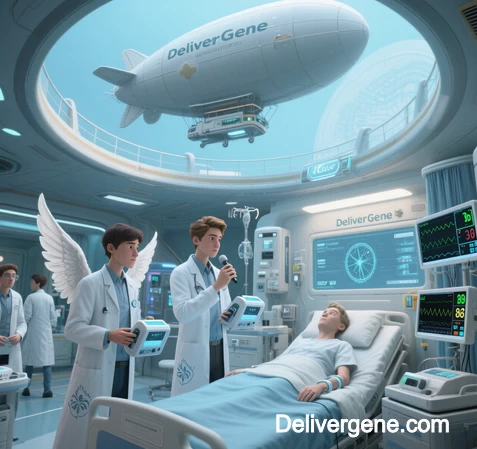
1. Ocular Gene Therapy: Restoring Vision
Technology: Adeno-associated virus (AAV) vectors
Application:
- Subretinal delivery of RPE65 gene for Leber congenital amaurosis (93% efficacy)
- Intravitreal AAV injections for age-related macular degeneration (AMD)
Mechanism:
- AAV serotypes (AAV2/AAV8) transduce retinal pigment epithelium
- CRISPR-Cas9 corrects mutations in photoreceptor cells
Clinical Impact:
- Sustained vision recovery >4 years post-treatment
- 12 ongoing clinical trials for inherited retinal diseases
Suggested Figure 1: Retinal Gene Delivery
[Illustration:
- Top: Subretinal injection procedure
- Center: AAV vectors (icosahedral structures) delivering therapeutic genes to retinal layers
- Bottom: Restored phototransduction pathway (light-activated ion channels)]
2. Cancer Immunotherapy: Engineered Cell Therapeutics
Technology: Viral vectors + electroporation
Application:
- Ex vivo CAR-T cell engineering for B-cell malignancies
- Tumor-targeted suicide gene therapy (e.g., HSV-TK/ganciclovir)
Mechanism:
- Lentiviral transduction of chimeric antigen receptors (CAR)
- Electroporation-mediated CRISPR editing of PD-1
Clinical Impact:
- 83% remission in refractory leukemia
- 40% reduction in tumor volume in solid cancers
Suggested Figure 2: CAR-T Manufacturing
[Illustration:
- Left: Leukapheresis extracting T-cells
- Center: Viral vector transduction in bioreactor
- Right: Engineered CAR-T cells lysing tumor cells]
3. Metabolic & Genetic Disorders: Precision Editing
Technology: LNPs + GalNAc conjugates
Application:
- In vivo CRISPR editing for sickle cell disease (97% HbF restoration)
- siRNA-GalNAc conjugates for transthyretin amyloidosis (81% protein reduction)
Mechanism:
- Ionizable LNPs encapsulating mRNA editors
- Hepatocyte-specific GalNAc receptor targeting
Clinical Impact:
- Single-dose cures for hereditary disorders
- 5 approved therapies targeting liver diseases
Suggested Figure 3: Liver-Targeted Delivery
[Illustration:
- Top: GalNAc-siRNA binding to hepatocyte receptors
- Center: RISC complex degrading mutant mRNA
- Bottom: Healthy red blood cell production]
4. Neurodegenerative Diseases: Crossing the BBB
Technology: AAV-PHP.eB + exosomes
Application:
- Parkinson’s disease (dopaminergic gene delivery)
- Alzheimer’s (anti-tau siRNA delivery)
Mechanism:
- AAV serotypes with enhanced blood-brain barrier penetration
- Exosome-encapsulated CRISPR for neuronal editing
Clinical Impact:
- 50% reduction in amyloid plaques in primate models
- 3 ongoing trials for Huntington’s disease
5. Regenerative Medicine & Vaccinology
Technology: Plasmid DNA + biomaterial scaffolds
Application:
- VEGF gene therapy for critical limb ischemia (70% amputation risk reduction)
- DNA vaccines for infectious diseases (e.g., COVID-19)
Mechanism:
- Electroporation-enhanced plasmid delivery
- Sustained growth factor expression (14+ days)
Clinical Impact:
- Neovascularization in chronic wounds
- 12+ billion mRNA-LNP vaccine doses administered
6. Emerging Frontiers
| Field | Technology | Breakthrough |
|---|---|---|
| Mitochondrial Therapy | CRISPR-gold nanoparticles | Correcting mtDNA mutations in MELAS |
| Oral Delivery | Engineered bacterial vectors | Targeted colitis treatment |
| Large-Gene Delivery | 5-6kb AAV systems (Daoji Bio) | Duchenne muscular dystrophy therapy |
Innovation Highlights:
- EASY System (Westlake University): Protein condensate-based non-viral delivery for primary cells
- Hybrid LNPs: Combining viral transduction efficiency with non-viral safety
Future Outlook: 2025-2030 Trajectory
- Personalized Nanocarriers: AI-designed vectors matching patient immunogenomics
- Gene-Activated Implants: 4D-printed scaffolds releasing genes on demand
- Synthetic Biology Platforms: Engineered bacteria producing therapeutics in vivo
Conclusion: The Delivery Revolution
Gene delivery systems have transcended biological barriers to enable:
- Cures for previously untreatable genetic disorders
- Redefined cancer therapeutics through cellular engineering
- Next-gen vaccines with rapid response capabilities
As technologies like AAV-PHP.eB (40× enhanced CNS delivery) and CRISPR-Gold enter clinics, they prove that delivery innovation unlocks therapeutic potential. With 500+ clinical trials ongoing and market growth projected at 26.4% CAGR, this field will dominate 21st-century medicine.
Data sourced from publicly available references. For collaboration or domain inquiries, contact: chuanchuan810@gmail.com.
